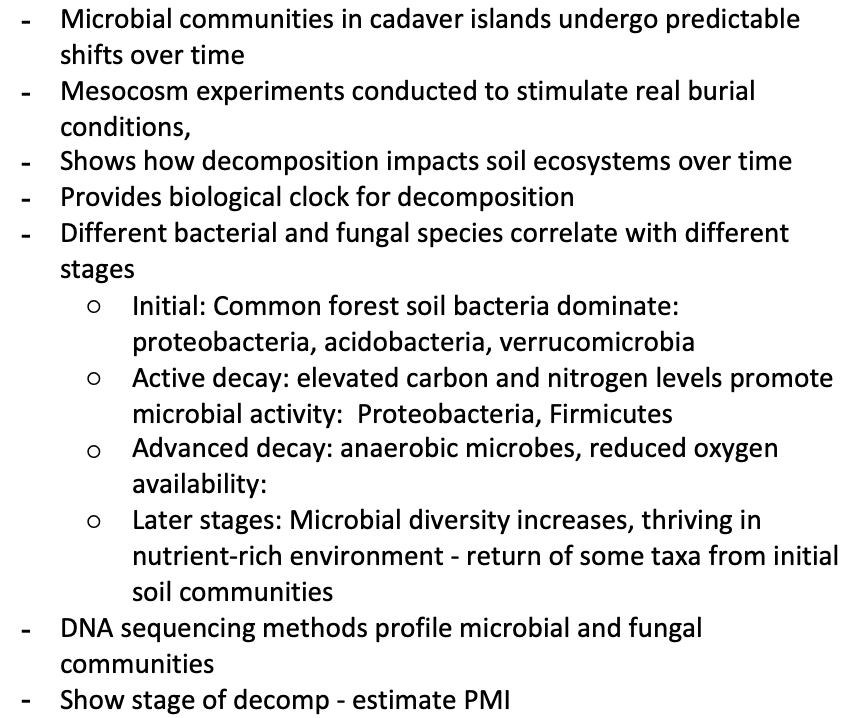Cadaver Islands and PMI Estimation
1/14
There's no tags or description
Looks like no tags are added yet.
Name | Mastery | Learn | Test | Matching | Spaced |
|---|
No study sessions yet.
15 Terms
PMI intro
Post-mortem Interval - estimation of time since death
PMI is important to reconstruct events surrounding death
facilitate solving crimes and identification
Estimate PMI by examining changes in the body after death - decomposition and its interaction with the environment
Decomposition causes microbial, fungal and chemical changes
creating zones called cadaver islands
Provide valuable data for estimating how long a body has been dead

What is decomposition
Breakdown of organic matter into simpler compounds through autolysis, putrefaction, and environmental interactions
Observable and measurable changes over time
Provide biological and ecological markers for PMI estimation
Decomposition stages
Generally categorised into 5 stages due to their different physical and microbial changes:
Fresh: Cellular self-digestion and microbial growth begin
Bloat: Accumulation of gases causes visible swelling
Active decay: Rapid tissue breakdown, liquefaction, and strong odors emerge
Advanced decay: Decomposition slows as nutrients deplete.
Skeletal Remains: Soft tissues have decayed, leaving bones.
Each stage can be identified by the physical and microbial changes
PMI can be estimated based on decomposition progress
Cadaver island
Nutrient-enriched soil zones formed beneath decomposing bodies
undergo distinct physical, chemical, and biological changes throughout decomposition.
Initial stages of decomp:
bodily fluids rich in nitrogen, phosphorus, potassium, and other organic compounds
seep into surrounding soil
change chemical composition
Active decay:
liquefaction of soft tissues
release of decomposition gases
Impact soil pH and oxygen levels
Advanced decay and skeletonisation:
remaining tissues decompose,
Enriching soil with nutrients
Form well-defined decomposition zones.
changes impact the soil properties, microbial diversity and vegetation patterns.
measurable, time-dependent changes that correlate with decomposition stages
valuable indicators for PMI estimation.
Soil Chemistry Changes
Chemical comp of cadaver islands change predictably:
Nitrogen, phosphorus, and potassium concentrations spike due to bodily fluids
Soil pH acidic due to decomposition fluids
Transitions to alkaline as decomposition progresses.
Collect and analyse soil regularly
Ion chromatography, mass spectrometry
Measure nutrient concentrations and pH
Quantify changes over time
Match soil conditions with known decomposition timelines to estimate PMI
Microbial Activity
Microbial communities in cadaver islands undergo predictable shifts over time
Mesocosm experiments conducted to stimulate real burial conditions,
Shows how decomposition impacts soil ecosystems over time
Provides biological clock for decomposition
Different bacterial and fungal species correlate with different stages
Initial: Common forest soil bacteria dominate: proteobacteria, acidobacteria, verrucomicrobia
Active decay: elevated carbon and nitrogen levels promote microbial activity: Proteobacteria, Firmicutes
Advanced decay: anaerobic microbes, reduced oxygen availability:
Later stages: Microbial diversity increases, thriving in nutrient-rich environment - return of some taxa from initial soil communities
DNA sequencing methods profile microbial and fungal communities
Show stage of decomp - estimate PMI

Fungal Dynamics
Fungi contribute to tissue degradation, nutrient cycling, environmental interactions
Fungal species associated with decomposition
Additional markers for PMI estimation
Mycoforensics links fungal dynamics with decomposition stages
Organ Specific Investigations
Microbiome in specific organs thanatomicrobiome undergo predictable changes after death
There are organ specific patterns: unique microbial shifts
Circulatory system
Lungs
Gastrointestinal tract
Profiling bacterial species in these organs and comparing them to known decomposition timelines
PMI estimation
Useful when external indicators are unreliable - severe environmental exposure, partial remains
Insect activity
Cadaver islands attract insects
Blowflies: Arrive shortly after death, laying eggs that develop into larvae and pupae at predictable rates.
Beetles and scavengers
Collect and analyse to determine species, developmental stages, colonisation patterns
Forensic entomology links insect activity to decomp stages
Estimate PMI based on life cycles and colonisation patterns
Impact on vegetation
Decomp fluids and gases impact vegetation
Early stages: toxic fluids kills flora, visible patches of dead vegetation
Later stages: nutrient enrichment promotes regrowth and biodiversity.
Changes in vegetation health and species composition
time markers
Remote sensing and imaging techniques
Drone based imaging
Detect patterns
Useful for finding clandestine burials
PMI estimation over large areas
Limitations - environmental variability
Soil composition, temperature, moisture influence decomposition rates
Arid environments slow decomp
Complicates estimation
Limitations - Animal and Insect Activity
Scavengers/burrowing animals disturb cadaver islands
misleading changes
Limitations - Time frame limitations
Most useful in early stages
Reliability decreases over time
Limitations - complex soil interactions
Pre existing soil conditions obscure decomp related changes
Limitations - Ethical and legislative constraints
Access to human remains limited
Rely on animal substitutes - pigs
Differences in physiology and decomposition dynamics pose challenges
Comparative studies between animals and human remains to bridge this gap